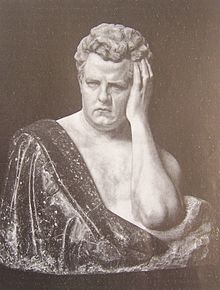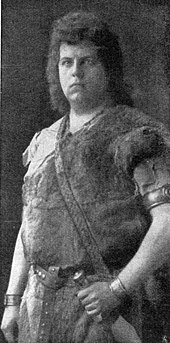Alfred von Bary
Alfred Erwin Cajetan Maria von Bary (born January 18, 1873 in Valletta , Malta ; † September 13, 1926 in Munich ) was a German neurologist and opera singer (tenor). He was also one of the most important Wagner tenors of the early 20th century.
Life
Alfred von Bary was born a British citizen in Valletta, Malta on January 18, 1873 and was baptized anglican. His father, the doctor Erwin von Bary , had settled here and was preparing for an expedition through the Sahara to Sudan . In 1877 he died in the southern Libyan caravan town of Ghat . After the older brother Richard (* 1870) died in Malta in 1877, the mother, Anna, born. Gramich returns to Munich, father's hometown, with Alfred.
Alfred von Bary entered the Maximiliansgymnasium in Munich on April 13, 1883 and passed the Abitur exams in 1892. He first studied medicine and was awarded a Dr. med. doctorate and licensed as a doctor. Until 1899 he worked as a second assistant doctor at the sanatorium for the mentally ill and nervous in Ahrweiler and then moved to Leipzig , where he took up an additional course in psychiatry at the university with the brain researcher Professor Paul Flechsig . Until 1901 he worked as an “insane doctor”.
As an assistant doctor in Leipzig, he sang in a choir in his spare time, where the famous conductor Arthur Nikisch discovered his voice. He took lessons in voice training and singing with Professor Richard Muller and developed a very sound beautiful and powerful tenor voice that made him the artist hero roles in the music dramas of Richard Wagner predestined. In 1902 he became a royal Saxon court singer (hero tenor) at the Dresden court opera. Already on his debut as Lohengrin the young singer caused a sensation. Engagements at leading German theaters followed. The main focus of artistic activity was the court operas in Dresden and Munich . With the pianist Alexander Dillmann he went on concert tours with performances in Basel, Berne, Gotha, Wiesbaden, Hanover, Düsseldorf, Frankfurt / M., Nuremberg and Budapest.
Between 1904 and 1914 he could be heard every year at the Bayreuth Festival , where he sang Lohengrin, Parsifal , Tristan and Siegmund as well as the role of Siegfried . Richard Wagner's widow Cosima and Kaiser Wilhelm II particularly valued the singer. In 1927, the music critic Albert von Puttkamer wrote in his book 50 Years of Bayreuth that von Bary was the best Lohengrin in the period before the First World War .
From 1912 von Bary settled in Munich, worked for a short time as a doctor and was a member of the Munich Medical Orchestra. In 1915 he and his wife moved into a villa with an adjoining studio building in the Bogenhausen district (Possartstrasse 35 and 37). After he was still in the autumn of 1914 by King Ludwig III. had been appointed royal court singer by Bavaria, the contract at the court opera was terminated on October 1, 1918 because of severe myopia, progressive blindness and vocal problems. From 1920 to 1925 he studied Catholic theology at Munich University, suffered a stroke in 1925 and died in 1926 of the consequences of another attack. He was buried in the Munich forest cemetery (grave site 7-W-9).
Alfred von Bary married Thekla Koch on January 15, 1902 in Dresden, from whom he divorced in 1908. In his second marriage he married the sculptor Jenny Doussin on January 9, 1909 in Dresden . She died on August 16, 1922 in Munich. Of the three sons in their first marriage, Siegmund (1903–1991) became a lawyer; Siegfried (1906–1976) and Gottfried (1907–?) Established themselves as doctors.
Alfred von Bary wrote essays on artistic or psychological questions. In contrast to his contemporary Enrico Caruso , however, he did not recognize the possibilities of the record. Therefore there are only two recordings of arias from Wagner's Walküre that give an impression of his powerful and excellently guided voice. The relatively short career and the lack of vinyl recordings have meant that Alfred von Bary is largely forgotten today.
A portrait of the singer hangs in the State Opera in Munich, a marble bust of different colors by Jenny von Bary is in the Staatliche Kunstsammlungen Dresden (inventory number ZV 2360 a). The marble bust "Alfred von Bary as sleeping Thannhäuser" and another marble portrait were offered as works by Jenny von Bary in the Munich art trade in 2003.
The Barystraße in Munich-Obermenzing was named after him.
Web links
- Alfred von Bary picture in the Manskopf Collection of the Johann Wolfgang Goethe University in Frankfurt am Main
- Bavarian Musicians Lexicon Online, ed. by Josef Focht, http://bmlo.de/b0161 (Version from August 24, 2015)
literature
- Glasenapp, Carl Friedrich : The life of Richard Wagner in 6 books. 6 volumes, 4th, revised edition, Leipzig: Breitkopf & Härtel, 1905.
- Germany, Austria-Hungary and Switzerland scholars, artists and writers in words and pictures, 1908.
- Roswitha von Bary: Alfred von Bary. A singer's life in Dresden, Bayreuth and Munich . Verlag Bild und Heimat, Reichenbach 2000 (with 27 illustrations), ISBN 3-7310-0414-3 .
Individual evidence
- ^ Annual report on the K. Maximilians-Gymnasium in Munich for the school year 1891/92
- ^ Thekla von Bary, née Koch * October 25, 1875 in Alt-Schönefeld ; † October 22, 1947 in Munich, daughter of the landowner Wilhelm Koch and Wilhelmine, née Hensel
- ^ Genealogisches Handbuch des Adels , Vol. 52, 1972, p. 23
| personal data | |
|---|---|
| SURNAME | Bary, Alfred von |
| ALTERNATIVE NAMES | Bary, Alfred Erwin Cajetan Maria von (full name) |
| BRIEF DESCRIPTION | German PhD neurologist and opera singer (tenor) |
| DATE OF BIRTH | January 18, 1873 |
| PLACE OF BIRTH | Valletta , Malta |
| DATE OF DEATH | September 13, 1926 |
| Place of death | Munich |

